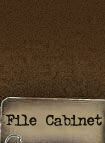|
|
Historical images compared with
the current situations in the exact
locations.
|
Normandy
Holland(1)
Ardennes
Worldwide
Miscellaneous
|
|

|
Eerde, September 17th 1944
Third Battalion of the 501st
Parachute Infantry Regiment lands on
Drop Zone A, outside Eerde. Both
pictures were taken at the
crossroads of two rural dirt tracks,
locally known as Wolven Steeg and
Veerse Heide.
(click on the
thumbnails to enlarge
Now & Then photographs)
 
|
.gif) |
Son, September 17th 1944
Helena Hoeve farm in Son,
Holland. This farm, owned by the
Roefs family in 1944, was featured
in our
Battle Study #6 .
Located on the Southern edge of Drop
Zones "B" and "C" and Landing Zone
"W" of the 101st Airborne Division,
Helena Hoeve served as an aid
station, mainly for jump and landing
injuries.
Medics and crippled paratroopers
pose with members of the Roefs
family.
(click on the
thumbnails to enlarge
Now & Then photographs)
_small.jpg) _small.jpg) |
.gif) |
Son, September 17th 1944
Helena Hoeve. Medics rest on the
lawn in front of the stable doors
where the Roefs kept their horse
cart. After the first day of
Operation "Market Garden",
casualties of the 101st were brought
to the divisional hospital in Son
proper.
(click on the
thumbnails to enlarge
Now & Then photographs)
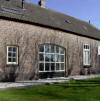 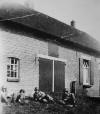 |
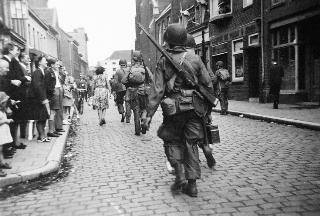 |
Eindhoven, September 18th 1944
Paratroopers of the 506th
Parachute Infantry Regiment move
East on Kerk Straat. The next day
this street would suffer extensive
damage due to a German bombing raid.
It explains why buildings' fronts on
the left in the "Now-" photo have
receded, creating a wider sidewalk.
(click on the
thumbnails to enlarge
Now & Then photographs)
  |
|

|
Eindhoven, September 18th 1944
Paratroopers of the 506th
Parachute Infantry Regiment
interrogate German prisoners on the
Dommel River bridge near the
Marienhage Convent. Both pictures
are taken from Kanaal Straat,
looking the corner of Bleek Straat.
"Then-"Photo through
BeeldbankWO2.nl
(click on the
thumbnails to enlarge
Now & Then photographs)
  |
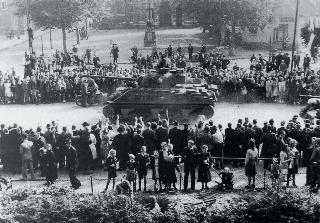 |
Eindhoven, September 18th 1944
Tanks of the 2nd Army enter
Eindhoven from the South on Stratumse
Dijk. Note the paratroopers at
bottom of picture digging a foxhole
in the garden of the old town hall
of Eindhoven. The building is no
longer there and we had to use a
ladder to recreate the
"Now"-photo.
(click on the
thumbnails to enlarge
Now & Then photographs)
  |
|

|
Eindhoven, September 18th 1944
Contrary to the caption of the
Now&Then comparison of this same
"Then-"photo in our
Holland(1)-page,
these soldiers of "E"-Co./506th are
not pictured on Hertog Straat, but
on Vest Dijk. We have left the
erroneous caption to illustrate some
of the pitfalls of this kind of
investigative work.
(click on the
thumbnails to enlarge
Now & Then photographs)
  |
|
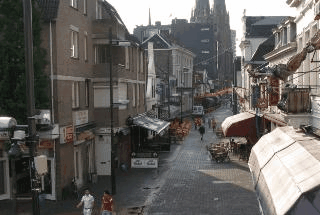
|
Eindhoven, September 18th 1944
Tanks of the British XXXth Corps
move North on Stratums Eind. Our
"Now-"photograph was taken from the
first floor of the Playerz Bar
with the courteous permission
of the proprietor.
(click on the
thumbnails to enlarge
Now & Then photographs)
  |
|

|
Eindhoven,
September 20th 1944
Two days later the street is in
ruins after the Luftwaffe's bombing
raid on the liberated city of
Eindhoven, which killed 200
civilians.
(click on the
thumbnails to enlarge
Now & Then photographs)
 
|
|
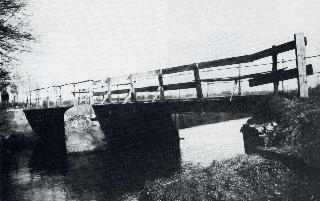
|
Eindhoven, September 19th 1944
A reconnaissance unit of the
German 107th Armored Brigade found
this bridge on the outskirts of
Eindhoven and judged it too weak to
cross. Popular post-war believe has
it that this bridge's weakness saved
Eindhoven from a horrible tank
battle. See our
Battle Study #13.
(click on the thumbnails to enlarge
Now & Then photographs)
  |
|
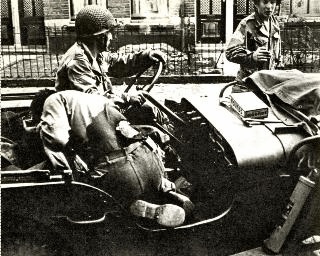 |
Nijmegen, September 20th 1944
A jeep driver speeds to bring a
wounded trooper of the 505th
Parachute Infantry Regiment, part of
the US Army's 82nd Airborne
Division, to an aid station. The
wounds were sustained during the
bloody battle for the Waal River
Bridge. This is Dominicanen Straat
in Nijmegen.
(click on the thumbnails to enlarge
Now & Then photographs)
  |
|
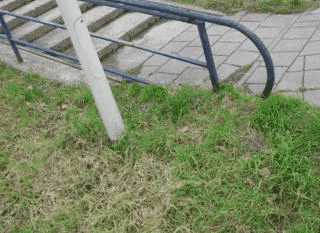 |
Nijmegen, September 20th 1944
A Tommy gunner of the 504th
Parachute Infantry Regiment of the
82nd Airborne lies dead at the
bottom of the steps of the North
ramp of the Waal River Bridge. This
paratrooper had, shortly before
meeting his death so close to the
504th's objective, heroically
crossed the river in small row boats
under heavy fire.
(click on the thumbnails to enlarge
Now & Then photographs)
  |
|
.gif) |
Zutphen, April 8th, 1945
Canadian engineers of the North
Shore Regiment use a mine detector
to remove mines on the approach to
the bridge on Arnhemse Weg in
Zutphen in the province of
Gelderland. German troops had blown
this bridge some days earlier to
slow the Allied advance into Eastern
Holland.
(click on the thumbnails to enlarge
Now & Then photographs)
_small.jpg) _small.jpg) |
|
.gif) |
Zutphen, April 8th, 1945
The bridge on Arnhemse Weg has
collapsed into the river. Because
the road deck remained relatively
intact, engineers have marked a safe
river crossing with white tape.
In 1947 this bridge was rebuilt and
named
"Canadians Bridge" in honor of
the liberators of Zutphen.
(click on the thumbnails to enlarge
Now & Then photographs)
_small.jpg) _small.jpg) |
|
.gif) |
Zutphen, April 8th, 1945
A Bren Carrier is parked on
Heeckeren Laan and its crew enjoy
the spring sun. Dutch citizens
have come out of their homes to
welcome the Canadian liberators.
(click on the thumbnails to enlarge
Now & Then photographs)
_small.jpg) _small.jpg) |
|
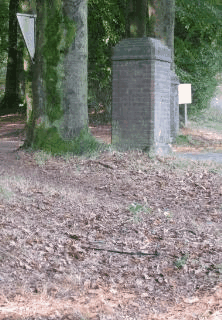 |
Oosterbeek, September 17th, 1944
Field grave of Frederick Walter
Hopwood of Mollington (Cheshire),
killed in action on the 17th of
September 1944. After the battle
Private Hopwood was reentered at the
Oosterbeek Airborne Cemetery.
In the United Kingdom Hopwood's name
is honored on
a war monument in Shotwick
(Cheshire).
Since the age of approximately 11, Battledetective Tom has had a
particular interest in this soldier
as shown in a
drawing in an elementary school
project he made at that age.
(click on the thumbnails to enlarge
Now & Then photographs)
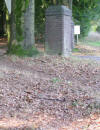 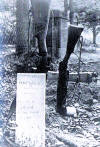 |
|
 |
's-Hertogenbosch, October 25th, 1944
Local hero Piet Kerssens is welcomed
into his hometown 's-Hertogenbosch
on Hinthamer Straat. Between 1941
and 1944 Piet had been in and out of
German captivity for trying to
escape to England. In August 1944 he
was able to join the advancing
Allied Forces and in October he was
instrumental in liberating his city.
Unfortunately Piet was wounded in
action on October 26th
at the bridge opposite the railway
station, 1944 and
died the following day.
(click on the thumbnails to enlarge
Now & Then photographs)
_small.jpg) _small.jpg) |
|
 |
's-Hertogenbosch, October 26th,
1944
This dramatic and often published
image of the liberation of
's-Hertogenbosch was taken by Army
photographer Peter Handford. A
British tank takes position at the
Esso fuel station on Willemsplein.
Not to refuel but to attack the
Willems Bridge. Mr. Van de Sande
from 's-Hertogenbosch carries his
young daughters into safety.
Today the Esso station is no longer
there and a local man showed us the
spot.
(click on the thumbnails to enlarge
Now & Then photographs)
_small.jpg) _small.JPG) |
|
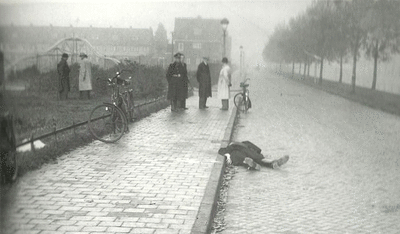 |
Haarlem, October 25th,
1944
On this day Dutch policeman Fake
Krist, who had been a fanatic Nazi,
collaborating with the Germans, was
executed by Dutch Resistance
fighters. The Germans retaliated at
this same location on Wester Gracht
and shot 10 innocent civilians and
torched four houses.
(click on the thumbnails to enlarge
Now & Then photographs)
  |
|
 |
Eindhoven September 18th,
1944
We (once more) stand corrected
about the exact location of a
photograph taken in Eindhoven,
Holland, on the 18th of September
1944. The girl in the
black-and-white striped socks in the
period photograph, Annie Molteni of
Frankrijk Straat No. 81 explained us
in January 2012 that the photograph
featuring her, Marietje van der
Vorst, Annie's brother Calimero
Molteni, choir director "Ciske"
Bakers, the Van den Broek sisters
and one (and a half) American
paratrooper was taken right in the
front yard of her home. We have
visited Annie and took a correct
comparison photo of her front yard.
(click on the thumbnails to enlarge
Now & Then photographs)
_small.jpg) _small.jpg) |
|
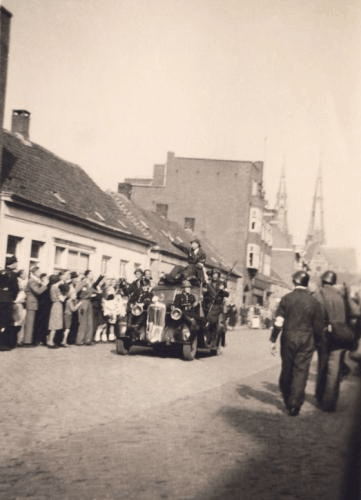 |
Eindhoven September 18th,
1944
Grote Berg in front of the main
police station.
The city of Eindhoven has just been
liberated by the US 101st Airborne
Division and members of the P.A.N. (Partizanen
Actie Nederland; Partisans Action
Netherlands) ride patrols in - and
on top of- a jalopy. Citizens cheer
them on. Later this day, the crowd
in front of the police station grew
when the word spread through the
city that arrested collaborators
where brought to the police station.
(click on the thumbnails to enlarge
Now & Then photographs)
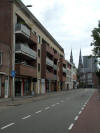 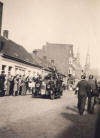 |
|
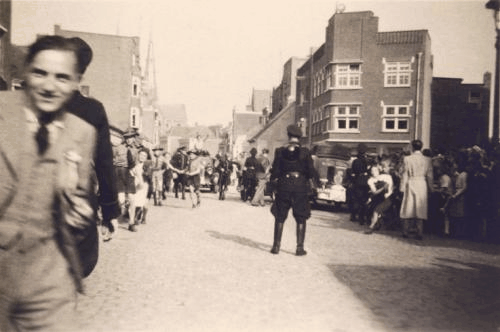 |
Eindhoven September 18th,
1944
Grote Berg in front of the main
police station.
Almost the same location as in the
previous comparison; note the twin
towers of the Saint Catharina Church
on Kerk Straat in the background.
The atmosphere is jubilant.
(click on the thumbnails to enlarge
Now & Then photographs)
  |
|
 |
Eindhoven September 18th,
1944
Dommel Straat at the Van den
Briel & Verster Linen Factory.
American paratroopers of the 506th
Parachute Infantry Regiment pose
with two citizens. The building was
a linen factory and as such in use
into the 1960�s. Until 2002 the
building housed a music theater.
When a new theater was
constructed next door, the former
factory was demolished, except its
outer wall. In the �Now-� photo the
new theater can be seen through the
glass-less windows. It is largely
obscured behind scaffolding wrapped
in green mesh. Behind the old wall
is an open-air stage.
(click on the thumbnails to enlarge
Now & Then photographs)
 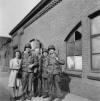 |
|
 |
Eindhoven May,
1945
Through the
contact form we were asked where
some photo's of Canadian soldier
Elwood Wilson, serving with the 65th
tank transport company, RCASC were
taken. We found the location on
Leeuwenstraat (Lion Street) in
Eindhoven, Holland.
(click on the thumbnails to enlarge
Now & Then photographs)
 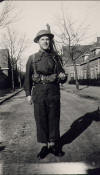
|
|
 |
Eindhoven May,
1945
Canadian soldier Elwood Wilson,
serving with the 65th tank transport
company, RCASC with his buddies on
Eindhoven's Leeuwenstraat.
(click on the thumbnails to enlarge
Now & Then photographs)
 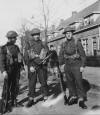 |
|
.gif) |
Eindhoven October 23rd,
1946
War damage on the corner of Demer
and Vrij Straat in Eindhoven.
Post-war "Then" photo taken in 1946
shows the destruction of all
buildings between Demer and the
Philips Light Tower on Emmasingel;
collateral damage of the December
6th 1942 bombing raid by the Royal
Air Force codenamed Operation
"Oyster" which targeted the Philips
factories. For details about this
raid see
Battle
Relic #26.
(click on the thumbnails to enlarge
Now & Then photographs)
_small.jpg) _small.jpg)
|
|
|
|
|
|
|
|
|
|
Back to Now&Then-Page |
|
|


